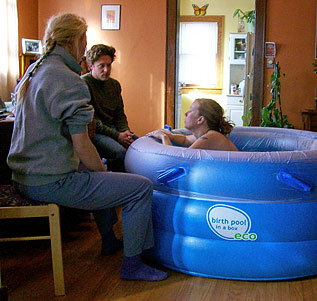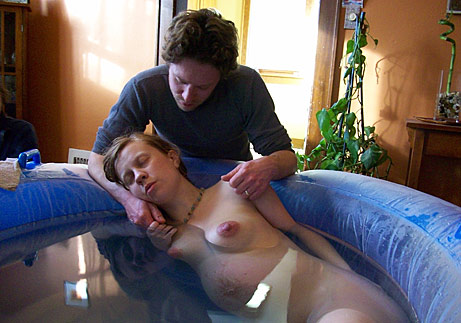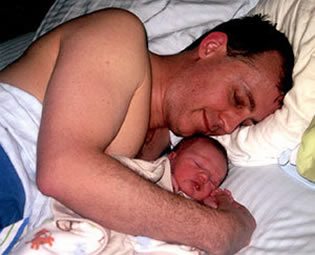Services
Some women call Community Midwives even before they are pregnant in order to begin exploring options between home and hospital or among midwives (see Links page for a midwife directory). Most women start with an interview, unless they have had babies with me before. Interviews last up to an hour, are free and take place at my home.
Typically, there is a student midwife working with me. The study of midwifery is an apprenticeship or immersion type of learning, as well as an academic one. Students attend all prenatal, labor, birth and postpartum/newborn visits. Students of nurse-midwifery typically work with me for a few months, while students of direct-entry midwifery may work with me for up to 3 years. All students, like midwives, are certified in Neonatal Resuscitation and Adult and Infant CPR. How much hands-on care a student offers depends on her didactic stage and level of experience. I select students carefully and feel you deserve the same privilege. If you are open to student involvement, my student will participate in our prenatal appointments, and after you get to know her I'll ask if she feels like a good fit for you and your family.
At birth, I call a second experienced licensed midwife to assist. The assistant may be another homebirth midwife or a midwife working in other capacities. Due to each midwife's limited availability, we can't be certain who the assistant will be until labor. You can meet all Madison homebirth midwives at monthly drop-in groups for families planning a homebirth, which we take turns facilitating. Groups occur every first Sunday of the month, 1:30pm-3pm, at Happy Bambino (see Links page for location) and offer a casual space to share stories, research, questions and expectations about anything related to pregnancy, birth and parenting.
Pregnancy, birth and parenting are shared life events — all your loved ones are welcome at Community Midwives. I invite you to include your partner, older children, and/or other support persons at interviews, appointments, prenatal groups and the annual community picnic.
Antepartum care
Prenatal appointments last up to an hour and typically take place at my home office, 3530 Lucia Crest in Madison (map here) on Tuesdays and Wednesdays, 9:30am-5:30pm. Most women choose to begin visits between 10 and 13 weeks. We meet once a month until 28 weeks, then every two weeks until your last month. At 36 weeks, the appointment takes place in your home. I can familarize myself with directions to your house, you can introduce me to your space and we can review supplies. If labor begins after 36 completed weeks and you and your baby appear healthy, you're safe to stay home. Remaining visits take place in my office, where we meet weekly until birth.
From the beginning of our course of care together, I will be on call for you 24/7 and you can feel free to call night or day with questions or concerns. Call as soon as possible if you have bleeding, severe persistent nausea or vomiting, severe abdominal or back pain, persistent headaches, visual blurring or flashes, can't recall when you last felt your baby move, think your water has broken, have chills or fever or any other serious concern.
During every prenatal visit we check your blood pressure, discuss screens, perform desired bloodwork, order desired ultrasounds, review your nutrition, activity, feelings, and levels of stress. We measure your baby's growth and assess position, movement, and heartbeat. I can teach you and your partner to do these too. We review national guidelines and discuss risks, benefits, research and alternatives. We review community class options, as well as books and dvds in my mother-and-child lending library.
I do not require or expect you to see a physician or hospital-based midwife during our care. I do ask you to identify a physcian for your newborn, as well as pre-register at the hosptial covered by your insurance. If you have an established positive relationship with a hospital-based physician or CNM prior to pregnancy, you may feel you don't need to see that individual unless indicated. Or conversely, you may feel you want to keep them in the loop. If you have no established relationship, or a less than positive relationship, you may want to meet a homebirth-supportive medical practitioner, in the event you or your baby develop a complication. I respect whatever path you take. In the event of complication or need for consultation, we will always be able to access a collaborative physician or hospital-based CNM.
Conditions and complications that indicate a need for consultation or transfer to medical care include: cardiac or other major active disease/illness; twins; placenta previa; preterm labor; preeclampsia; pregnancy induced hypertension; and persistent breech presentation. If desired, we can continue to work together to ensure continuity of care through birth, breastfeeding, and postpartum.
Intrapartum care
As always, plans are indivualized and your body and baby lead. See the Birth Stories page and Supplies and Preparation page (the Preparing for Birth handout) to review what labor and birth can feel and look like at home.
I join you at your home when you're in active labor. If you've had a baby before or your water breaks early, I will likely join you sooner than if this is your first baby and your amniotic sac is intact. Timing is typically determined over the phone by both of us and your partner.
When I arrive, I carefully assess you and your baby, and together with everyone present, discuss how labor is progressing and any immediate needs. After confirming good labor progress and support, I set up my equipment, then the labor pool if desired and if time allows. I assess your baby's heartbeat at regular intervals with a hand-held doppler that allows you to be in any position and works well under water.

My student and I might arrive together, or she might arrive after I do. I ask my midwife assistant to join us when you are in late active labor. We are committed to maintaining the environment and type of support that work best for you. These can change moment to moment, hour by hour. At times you may like continual verbal affirmation, massage or counterpressure, at other times you may tell us to stop talking or touching you. You may be quiet, with eyes closed, or you may be yelling and swearing. You may want the labor pool set up and then find you never use it, or you may like it for labor but not for pushing. Or, you may never want to get out.
We encourage you to turn your mind over to your body and baby this way. Labor and birth always work best when your sense of trust and safety stay strong.

If a complication or serious concern arises I will ask you to get out of the pool for better assessment and response. If the issue does not resolve with first-line medical equipment and midwifery skills, a homebirth plan changes to a hospital plan. During the shift, assessments and communication remain continual and inclusive. The trip from home to hospital is typically by car and very smooth.
In the unlikely event that an ambulance is called, first responders and paramedics work collaboratively with us and acknowledge midwives as experts in labor and birth. Whether in a car or an ambulance, someone in your birth team stays by your side. Hospital staff receive a thorough labor report from me by phone (as well as in person) and will admit you directly into a room. Hospital nurses, midwives and physicians acknowledge and respect the fact that you had hoped to birth at home. You will remain at the center of decision-making and your established labor team is welcome.
Whether at home or in hospital after your baby is born, by planning to birth at home with a midwife you ensure experienced, skilled and trusted continuity of care, as well as the certainty that you have done everything within your power to prevent complications and minimize interventions.
Postpartum Care
We do not leave your home until we're certain you and your newborn are stable, practicing breastfeeding skills and all your needs and requests are met (no less than two hours after birth). During the first 24 hours following birth, we ask that you have alert assistance immediately available to you as needed.
Immediately after birth, some babies need help removing scretions or breathing. We provide deep suctioning and oxygen on the floor or bed with the umbilical cord still attached. Leaving the cord attached is critical for flow of oxygenated blood when your baby most needs it, meanwhile your close presence and voice supply safety and comfort.
We guide you and your partner to lift your baby up and place your baby on your abdomen. While your baby lies skin-to-skin, we monitor your bleeding and wait for your uterus to contract as it works to deliver the placenta. As your baby crawls toward and nuzzles your breast, your uterus will receive surges of oxytocin and typically expel the placenta within 30 minutes, often before the cord has been cut. If your uterus is not contracting by 30 minutes, I will ask you to stand up, walk to the bathroom or squat. Change in movement usually results in placental delivery. If your placenta still has not come, I'll recommend an injection of pitocin to stimulate uterus contractions until the placenta delivers.
 While you remain skin-to-skin with your baby, we work to meet your wishes for your delivered placenta, as well as newborn procedures and screens. We also examine your tissues for tearing and perform necessary perineal stitching (using lidocaine). When you are ready to attempt to empty your bladder (important for minimizing bleeding), we will walk with you and review postpartum cares, while your partner holds the baby skin-to-skin. Skin-to-skin care is crucial the first 24 hours of life as your baby imprints on your faces and voices, regulates his or her body temperature, teaches you feeding cues and works to limit maternal bleeding as well as bring in your milk. After returning to bed, we perform a newborn head-to-toe exam. Before departure, I complete a Birth Certificate worksheet.
While you remain skin-to-skin with your baby, we work to meet your wishes for your delivered placenta, as well as newborn procedures and screens. We also examine your tissues for tearing and perform necessary perineal stitching (using lidocaine). When you are ready to attempt to empty your bladder (important for minimizing bleeding), we will walk with you and review postpartum cares, while your partner holds the baby skin-to-skin. Skin-to-skin care is crucial the first 24 hours of life as your baby imprints on your faces and voices, regulates his or her body temperature, teaches you feeding cues and works to limit maternal bleeding as well as bring in your milk. After returning to bed, we perform a newborn head-to-toe exam. Before departure, I complete a Birth Certificate worksheet.
Postpartum home visits typically occur 24-36 hours after birth, on day 3 and again at about 2 weeks. At each visit, I carefully examine you and your baby, provide desired tests and screens and assess and assist lactation. I administer maternal rhogam within 72 hours, if needed. I offer every family a customized birth summary card, in which I can place newborn footprints. I remain on call 24/7 for you and your baby.
In the event of a complication or serious concern, we discuss a plan for physician follow-up or initiate transfer to the neonatal intensive care unit covered by your insurance. As long as you and your baby remain healthy, I don't require or expect either of you to see a physician prior to our final visit at about 6 weeks after birth. I fax a birth summary to your physician, as well as postpartum visit reports.
Our final visit takes place at my home office, where I schedule over an hour for reviewing your birth and new motherhood stories, breastfeeding, physical and emotional adjustments and future health and work plans. It's a chance for your baby to see the place where we all met those many weeks, and for us to say goodbye...until we meet again.

Back to top